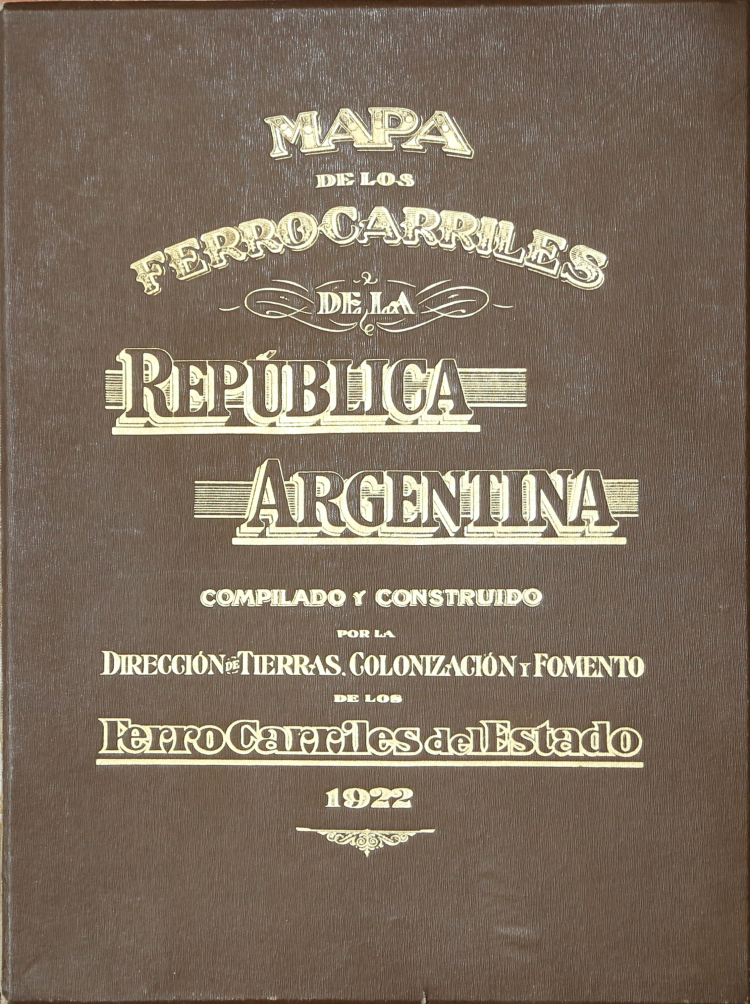




| Reference: | S33977 |
| Author | Jacob ed. PEUSER |
| Year: | 1922 |
| Zone: | Argentina |
| Printed: | Buenos Aires |
| Measures: | 1590 x 2820 mm |



| Reference: | S33977 |
| Author | Jacob ed. PEUSER |
| Year: | 1922 |
| Zone: | Argentina |
| Printed: | Buenos Aires |
| Measures: | 1590 x 2820 mm |
Extremely rare and very large folding map of the railroads of Argentina, dated 1922, with twenty-two inset town plans, edited in Buenos Aires by the famous publishing company " Jacobo Peuser" .
Compiled and realized by the ""Dirección de tierras, colonización y fomento de los Ferrocarriles del Estado".
It has a significant historical interest due to the fact that it relates to the "Golden Age" of railroads in Argentina.
In Argentina, the State financed, built, and ran government-own railroads based on recourse to subsidies until the first Yrigoyen administration (1916-1922), which introduced changes and shifted the direction of rail policy somewhat. The Ferrocarriles del Estado contributed to the development of science, created a demand for professionals which helped form the professional engineering field, and, by linking the capitals of central and northern provinces, facilitated both communications and scientific tasks themselves, especially research into diseases endemic to the country.
Lithograph printed in colors, original outer case, in very good condition.
- See more at: http://www.swaen.com/antique-map-of.php?id=16081#sthash.azMIEuTK.dpuf
Jacob ed. PEUSER (1867 - 1964)
|
Born in the town of Bad Camberg in the Duchy of Nassau (later annexed to Prussia) in 1843, the parents of Jacobo Peuser arrived in Argentina in 1855 when he was 12 years old. Instead of settling in the capital, they moved to the province of Santa Fe. Young Jacobo inclined toward graphic arts & all aspects of book production, founding one of the most successful publishing companies in Argentina. From 1867 until the beginning of the 20th century, the Peuser empire continued to expand with several production plants in Buenos Aires & branches in most major cities in Argentina. Peuser passed away in 1901 just before his 58th birthday. After his death the business was continued by his heirs and co-workers who opened subsidiaruy braches alla over country. During the company’s long existance, Peuser became best known for guidebooks. The predecessor for the modern day Guía T, the little red Guía Peuser contained numerous, invaluable listings for Buenos Aires: street names, transportation timetables, business directories… no household was without one. Peuser also expanded into national tourism, making an equivalent of the Michelin Guide in Argentina. The activity ceased in 1964.
|
Jacob ed. PEUSER (1867 - 1964)
|
Born in the town of Bad Camberg in the Duchy of Nassau (later annexed to Prussia) in 1843, the parents of Jacobo Peuser arrived in Argentina in 1855 when he was 12 years old. Instead of settling in the capital, they moved to the province of Santa Fe. Young Jacobo inclined toward graphic arts & all aspects of book production, founding one of the most successful publishing companies in Argentina. From 1867 until the beginning of the 20th century, the Peuser empire continued to expand with several production plants in Buenos Aires & branches in most major cities in Argentina. Peuser passed away in 1901 just before his 58th birthday. After his death the business was continued by his heirs and co-workers who opened subsidiaruy braches alla over country. During the company’s long existance, Peuser became best known for guidebooks. The predecessor for the modern day Guía T, the little red Guía Peuser contained numerous, invaluable listings for Buenos Aires: street names, transportation timetables, business directories… no household was without one. Peuser also expanded into national tourism, making an equivalent of the Michelin Guide in Argentina. The activity ceased in 1964.
|